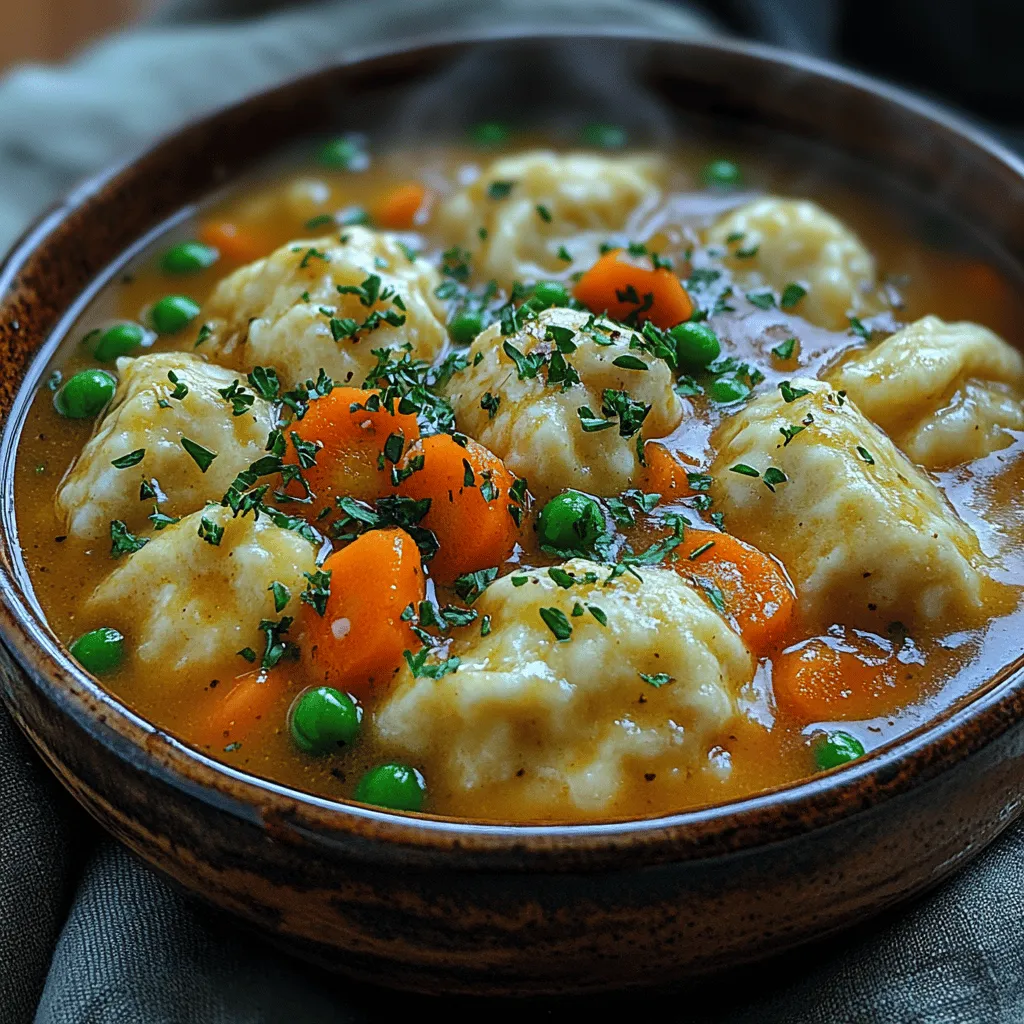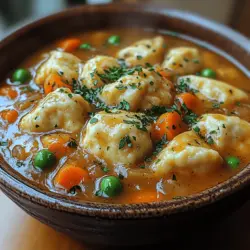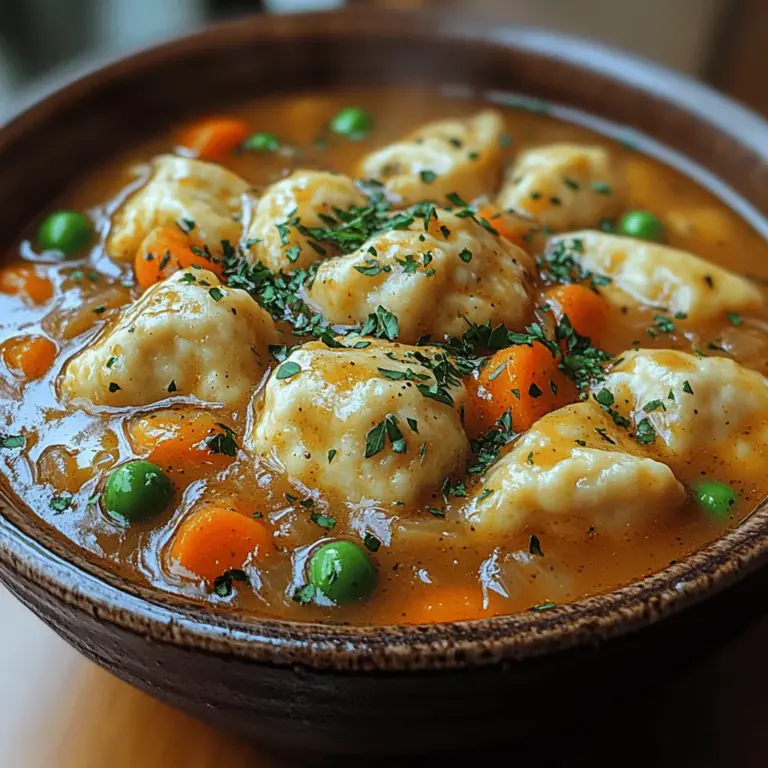When the chill of winter settles in or a rainy day calls for something soothing, few dishes can compare to a warm bowl of Cozy Comfort Chicken and Dumplings. This classic dish, with its rich, savory chicken stew and fluffy dumplings, encapsulates the essence of comfort food. It’s not just a meal; it’s an experience that conjures up feelings of nostalgia, warmth, and home. Whether enjoyed on a family gathering or a quiet evening, chicken and dumplings provide a perfect blend of flavors and textures that leave you feeling satisfied and content.
The Emotional Connection to Comfort Food
Comfort food holds a special place in our hearts, often linked to fond memories and family traditions. We all have those dishes that remind us of home, of gatherings around the dinner table, and of loved ones. Chicken and dumplings, in particular, are steeped in history and tradition, often associated with southern cooking in the United States. This dish not only fills the stomach but also nourishes the soul, making it a go-to choice for anyone seeking a little comfort during tough times.
In this article, we’ll take a deep dive into the world of Cozy Comfort Chicken and Dumplings. You’ll learn about the essential ingredients that contribute to this hearty dish, the preparation steps that make it a household favorite, and tips for achieving the best results. Whether you’re a seasoned chef or a cooking novice, this recipe will guide you through the process of creating a comforting meal that everyone will love.
Understanding the Ingredients
To create the ultimate Cozy Comfort Chicken and Dumplings, it’s crucial to understand the ingredients that make up this delightful dish. Each component plays a vital role in developing the deep flavors and satisfying textures that we associate with comfort food.
Chicken Stew Components
At the heart of our dish lies the chicken stew, which is the foundation of the meal. Here’s a closer look at the key ingredients that contribute to the rich, hearty flavor profile:
– Boneless, Skinless Chicken Breasts: This cut of chicken is favored for its convenience and lean texture. Boneless, skinless chicken breasts cook quickly and are easy to shred, making them perfect for our stew. If you prefer a more flavorful option, you can opt for bone-in chicken thighs, which add an extra depth of flavor due to their higher fat content. Alternatively, rotisserie chicken can be used for a quick and easy solution, cutting down on prep time while still delivering delicious results.
– Vegetables: The addition of vegetables not only enhances the flavor of the stew but also adds nutrition and texture. Onions and garlic form the aromatic base, providing a savory foundation. Carrots and celery contribute sweetness and earthiness, balancing the dish. Together, these vegetables create a comforting medley that permeates the stew with warmth.
– Chicken Broth: The quality of chicken broth can make or break your dish. A rich, flavorful broth will enhance the overall taste, providing a luscious backdrop for the chicken and vegetables. Homemade broth is often the best choice, but if you’re short on time, a high-quality store-bought broth can work just as well. Look for low-sodium options to better control the seasoning in your stew.
– Herbs and Seasonings: Fresh herbs play a crucial role in elevating the dish. Thyme offers a subtle earthiness that complements the chicken and vegetables perfectly, while parsley adds freshness and brightness to the final dish. Using fresh herbs, when possible, will significantly enhance the flavor profile, making your chicken and dumplings even more delightful.
– Frozen Peas: These little gems add a pop of color and sweetness to the stew. They are convenient and packed with nutrients, making them an excellent addition to our dish. Plus, they require no prep time—just toss them in during the final stages of cooking for a burst of flavor and texture.
Overview of the Dumpling Ingredients
No chicken and dumplings dish is complete without the fluffy dumplings that sit atop the savory stew. Let’s break down the key ingredients that contribute to their delightful texture:
– Flour and Baking Powder: The foundation of our dumplings, flour provides structure, while baking powder acts as a leavening agent, helping the dumplings rise and become fluffy. It’s essential to measure the flour accurately and ensure it’s sifted to avoid any lumps.
– Milk and Butter: These ingredients add moisture and richness to the dumpling dough. Milk hydrates the flour, allowing it to form a cohesive dough, while butter adds a luscious flavor and tender crumb. For a lighter option, you can substitute milk with buttermilk, which will also add a slight tang.
– Fresh Parsley: A touch of fresh parsley not only brightens the flavor of the dumplings but also adds a pop of color. It’s a simple addition that can elevate the overall presentation of the dish.
Preparation Steps Explained
Now that we’ve covered the essential ingredients, let’s walk through the preparation steps to create this hearty Cozy Comfort Chicken and Dumplings. Following these steps will ensure your stew is flavorful and your dumplings are perfectly fluffy.
Cooking the Chicken Stew
1. Brown the Chicken: Start by heating a large pot or Dutch oven over medium-high heat and adding a splash of oil. Season the boneless, skinless chicken breasts with salt and pepper, then add them to the pot. Sear the chicken for about 4-5 minutes on each side until golden brown. This step is crucial as it develops a rich flavor that will enhance the stew.
2. Sauté the Vegetables: Once the chicken is browned, remove it from the pot and set it aside. In the same pot, add diced onions, minced garlic, chopped carrots, and celery. Sauté these vegetables for about 5-7 minutes until they are softened and fragrant. The residual bits left in the pot from browning the chicken will infuse the vegetables with added depth.
3. Add Chicken Broth: Return the chicken to the pot and pour in the chicken broth, scraping the bottom to release any browned bits. This will add even more flavor to your stew. Bring the mixture to a gentle simmer, allowing it to cook for about 20-30 minutes. This simmering process melds the flavors and ensures the chicken cooks through.
4. Adjust Seasoning: As the stew simmers, taste and adjust the seasoning as needed. You can add additional salt, pepper, or herbs to your preference. Remember, the key is to develop a balanced flavor that complements the chicken and vegetables.
5. Add Peas: About 5 minutes before the stew is finished cooking, stir in the frozen peas. They’ll heat through quickly while retaining their vibrant color and sweetness.
Making the Dumplings
1. Prepare the Dough: In a mixing bowl, combine the flour, baking powder, and a pinch of salt. In a separate bowl, whisk together the milk and melted butter. Gradually add the wet ingredients to the dry ingredients, mixing until just combined. Be careful not to over-mix; you want to keep the dumplings tender and fluffy.
2. Form the Dumplings: Using a spoon or your hands, scoop out portions of the dough and gently drop them onto the surface of the simmering stew. Leave some space between them, as they will expand while cooking.
3. Cook the Dumplings: Cover the pot with a lid and allow the dumplings to steam for about 15-20 minutes. It’s important not to lift the lid during this time, as the steaming process is crucial for fluffy dumplings. They should puff up and become light and airy.
4. Finishing Touches: Once the dumplings are cooked through, sprinkle with fresh parsley for a burst of color and flavor. Serve the chicken stew hot, ladling it into bowls with a generous helping of dumplings on top.
In the following section of this article, we’ll delve deeper into tips for achieving the best results with your Cozy Comfort Chicken and Dumplings, as well as address some common questions that arise during the cooking process. Stay tuned for a comprehensive guide that will help you perfect this beloved dish, ensuring that every bite is filled with warmth and comfort.

Steaming Process for Perfect Dumplings
To achieve perfect dumplings that are fluffy and tender, the steaming process is crucial. Steaming allows the dumplings to cook gently, retaining moisture and preventing them from drying out. To steam your dumplings effectively, consider the following steps:
1. Prepare Your Steamer: If you have a traditional bamboo steamer, line it with parchment paper or cabbage leaves to prevent sticking. If using a metal steamer basket, ensure it is well greased or lined.
2. Even Spacing: Place the dumplings in the steamer with enough space between them to allow for expansion as they cook. Overcrowding can lead to uneven cooking and sticking.
3. Steam Time: Bring water to a rolling boil and then reduce to a gentle simmer. Place your steamer over the pot, cover tightly, and steam for about 15 to 20 minutes. Check one dumpling by cutting it in half to ensure it is cooked through.
4. Check for Doneness: The dumplings should be soft and slightly springy to the touch. If they appear too sticky, they may need an additional minute or two in the steamer.
Cooking Techniques and Tips
Sautéing Techniques for Optimal Flavor
Sautéing is a key technique in preparing the chicken and vegetable base for your stew. Start by heating a tablespoon of oil in a large pot over medium-high heat. The goal is to develop a rich flavor base, so consider these tips:
– High Heat: Use a high enough heat to create a nice sear on the chicken pieces. This caramelization adds depth to the dish.
– Don’t Overcrowd: Cook the chicken in batches if necessary. Overcrowding can steam the chicken instead of browning it, resulting in less flavor.
– Deglaze the Pot: After sautéing, add a splash of broth or wine to the pot to deglaze. Scrape up any browned bits from the bottom, which enhances the flavor of your stew.
The Significance of Simmering for Depth in Chicken Stew
Simmering is essential for melding the flavors of the chicken, vegetables, and broth. Once you’ve added the broth to your sautéed ingredients:
– Low and Slow: Bring the broth to a gentle simmer rather than a rolling boil. This allows the chicken to become tender without toughening.
– Time for Flavor Development: Allow the stew to simmer for at least 30 minutes. This time is crucial for the chicken to break down and for the vegetables to soften, infusing the broth with their flavors.
Exploring the Steaming Method for Dumplings and Its Effects on Texture
Steaming dumplings creates a unique texture that is soft, fluffy, and light. Unlike boiling, which can make dumplings heavy and soggy, steaming retains their structure. As they steam, they absorb the surrounding moisture without becoming waterlogged.
How to Ensure Even Cooking and Seasoning Adjustment
To ensure even cooking and properly adjusted seasoning:
– Uniform Size: Make sure your dumplings are of uniform size for consistent cooking.
– Taste as You Go: Before adding the dumplings to the stew, taste the broth and adjust the seasoning with salt, pepper, or herbs to your liking.
Nutritional Benefits of Chicken and Dumplings
Chicken and dumplings not only provide comfort but also deliver several nutritional benefits:
– Protein Content from Chicken: Chicken is an excellent source of lean protein, vital for muscle development and repair. It also supports immune function and overall health.
– Vitamins and Minerals from Vegetables: The vegetables in the stew contribute essential vitamins and minerals. Carrots offer beta-carotene, while celery and onions provide antioxidants and fiber, promoting digestive health.
– Balanced Meal Considerations: This dish combines protein, carbohydrates from the dumplings, and vitamins from the vegetables, creating a well-rounded meal that can sustain energy levels throughout the day.
Variations on the Classic Recipe
Chicken and dumplings is a versatile dish that can be adapted to suit various dietary preferences and tastes:
– Ingredient Swaps: For a healthier twist, consider using turkey instead of chicken. For a vegetarian option, swap the chicken for hearty vegetables like mushrooms, zucchini, or chickpeas along with vegetable broth.
– Regional Variations: Explore how different cultures create their versions of chicken and dumplings. For instance, in the American South, you might find a richer, creamier stew, while in parts of Asia, dumplings may be filled with minced meat and served in a broth.
– Adding Different Herbs and Spices: Experiment with herbs like thyme, rosemary, or dill to give your dish a unique flavor profile. A pinch of nutmeg or allspice can also add warmth and depth.
Serving Suggestions
To make your chicken and dumplings even more enjoyable, consider these serving suggestions:
– Ideal Sides: A simple green salad or steamed vegetables pairs well with this dish, adding a refreshing contrast. Alternatively, a warm crusty loaf of bread can be served alongside for dipping purposes.
– Presentation for Gatherings: When serving chicken and dumplings for gatherings or family meals, consider using a large, attractive serving bowl. This not only makes it easier for guests to serve themselves but also enhances the meal’s visual appeal.
– Pairing Options: For beverages, a light white wine, such as Sauvignon Blanc or a mild red, like Pinot Noir, complements the flavors of chicken and dumplings. Herbal teas, like chamomile or mint, also make a soothing accompaniment.
Conclusion
Making chicken and dumplings is more than just cooking; it encapsulates the essence of comfort and togetherness. As you prepare this dish, you nurture not only your body with its wholesome ingredients but also your soul through the joy of cooking and sharing a meal with loved ones. The aromas wafting through your kitchen as it simmers on the stove will create an inviting atmosphere that encourages everyone to gather around the table.
We encourage you to try this cozy recipe and savor the delightful experience it brings. Whether enjoyed on a chilly evening or as a treasured family tradition, chicken and dumplings is a dish that warms the heart and nourishes the spirit. Embrace the joy of cooking, and remember that the best meals are those shared with family and friends.


